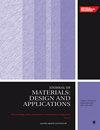基于神经网络的发泡聚苯乙烯泡沫压缩应力建模:关注珠粒尺寸参数
IF 2.2
4区 材料科学
Q3 MATERIALS SCIENCE, MULTIDISCIPLINARY
Proceedings of the Institution of Mechanical Engineers, Part L: Journal of Materials: Design and Applications
Pub Date : 2024-01-09
DOI:10.1177/14644207231224172
引用次数: 0
摘要
发泡聚苯乙烯用途广泛,主要用于保护和结构用途。其缓冲性和机械强度在抗压负荷下表现出色,尤其是在优化设计的情况下。影响其压缩应力的一个关键因素是初始密度,它在决定材料的机械性能方面起着重要作用。这方面主要取决于珠粒的大小分布。尽管有大量文献对发泡聚苯乙烯的应力响应进行建模,但对考虑到这一因素的预测却重视有限,而这一因素也与材料的制造有关。最近的文献强调了人工神经网络在预测发泡聚苯乙烯抗压行为方面的能力,并纳入了各种因素。本研究使用人工神经网络模型预测聚苯乙烯泡沫的压缩应力响应,重点关注珠粒尺寸分布参数。使用显微照片检查了两种不同初始密度的试样,以确定珠粒直径和分布,然后将其用作模型输入。对这些试样进行了两种不同速率的压缩试验。收集到的数据有助于开发材料压缩行为的预测模型。模型预测结果与实验结果非常吻合,误差指标显示与实验数据相比偏差小于 3%。这凸显了人工神经网络在聚苯乙烯泡沫压缩行为建模中的实用性,尤其是在考虑到珠粒尺寸和相关参数的情况下。本文章由计算机程序翻译,如有差异,请以英文原文为准。
Neural networks-based modeling of compressive stress in expanded polystyrene foams: A focus on bead size parameters
Expanded polystyrene is used in diverse applications, notably for protective and structural purposes. Its cushioning and mechanical strength excel under compressive loads, especially when optimally designed. A key factor influencing its compressive stress is the initial density, which plays a significant role in determining the material’s mechanical properties. This aspect is primarily determined by the bead size distribution. Although there is a vast body of literature on modeling the stress response of expanded polystyrene, there is limited emphasis on predictions that account for this factor, which is also relevant for the manufacturing of the material. Recent literature has emphasized the capability of artificial neural networks in predicting the compressive behaviors of expanded polystyrene, incorporating various factors. In this study, artificial neural network models were used to predict the compressive stress responses of polystyrene foams, with a focus on bead size distribution parameters. Specimens of two distinct initial densities were examined using micrographs to identify bead diameters and distributions, which were then used as model inputs. Compression tests on these specimens were conducted at two different rates. The collected data facilitated the development of predictive models for the material’s compressive behavior. The model predictions closely match experimental findings, with error metrics showing deviations <3% compared to the experimental data. This highlights the utility of artificial neural networks in modeling the compressive behavior of polystyrene foams, particularly when bead size and related parameters are considered.
求助全文
通过发布文献求助,成功后即可免费获取论文全文。
去求助
来源期刊

CiteScore
4.70
自引率
8.30%
发文量
166
审稿时长
3 months
期刊介绍:
The Journal of Materials: Design and Applications covers the usage and design of materials for application in an engineering context. The materials covered include metals, ceramics, and composites, as well as engineering polymers.
"The Journal of Materials Design and Applications is dedicated to publishing papers of the highest quality, in a timely fashion, covering a variety of important areas in materials technology. The Journal''s publishers have a wealth of publishing expertise and ensure that authors are given exemplary service. Every attention is given to publishing the papers as quickly as possible. The Journal has an excellent international reputation, with a corresponding international Editorial Board from a large number of different materials areas and disciplines advising the Editor." Professor Bill Banks - University of Strathclyde, UK
This journal is a member of the Committee on Publication Ethics (COPE).
 求助内容:
求助内容: 应助结果提醒方式:
应助结果提醒方式:


